![]()
![]()
![]()
Use LEFT and RIGHT arrow keys to navigate between flashcards;
Use UP and DOWN arrow keys to flip the card;
H to show hint;
A reads text to speech;
59 Cards in this Set
- Front
- Back
- 3rd side (hint)
|
Coral bleaching
|
An increase of water temperature/pH, puts the coral under stress, the algea move out. So the coral looses it's food source and colour.
|
What causes coral bleaching?
|
|
|
Deadzones
|
Where Ecosystems have collapsed completely.
|
|
|
|
Why are coral reefs important?
|
-biodiversity
-medical research -tourism -fishing -aquarium business -shoreline protection -education |
List of everything it provides
|
|
|
What is a keystone with species?
|
It is the most important species in the food web which everything rely on.
|
|
|
|
What is siltation?
|
Siltation is when the soil is on held in place due to deforestation, so it is washed away into the deep ocean. This causes pollution to the ocean because of the sediments impacting on animals causing dead zones.
|
Soil washed away
|
|
|
Asteroid collision theory
|
Asteroid collide with the earth. A large impact would blast ash into atmosphere. Cooling the earth when it blocks the sunlight.
|
|
|
|
Eruption theory
|
Big volcanoes change the earths climate, ash and sulphur dioxide gas. If the ash rises high enough blocking the sunlight, cooling the planet.
|
|
|
|
What is global warming?
|
Carbon dioxide in the atmosphere blocks the sun's radiation so it warms the planet.
|
|
|
|
Why is climate change?
|
Climate change is measured from the average of the past 30 years.
|
How is it measured?
|
|
|
What is the enhanced greenhouse effect?
|
Human activity such as deforestation and burning fossil fuels enhance the greenhouse effect.
|
|
|
|
Sunspots and solar output theory?
|
Sunspots are black areas on the sun, more spots mean more solar energy (solar output). The little ice age and medieval warm period was caused.
|
|
|
|
Climate of the recent past
|
-books
-records -paintings/photographs -records of harvests -migrating birds in records |
What tells us about the recent past.
|
|
|
Milonkovitch cycle
|
-orbital theory - earths orbit changes to a circular orbit to a elipse. It happens over millions of years.
-tilt theory - the earths axis tilts and straitens gradually over years. -wobble theory - the earths axis wobbles. As it wobbels closer to the sun the earth becomes warmer. |
The three theories.
|
|
|
Climate of the past
|
Ice cores
-the size of the crystals, big crystals means it is colder T the time of formation -bubbles in the ice, the atmosphere is trapped in the bubbles |
What tells us about the climate of the past?
|
|
|
What will happen when the climate changes?
|
-average temperature rises
-less rain and longer summers -sea levels rise -more storms and droughts -Ecosystems change when species move -more disease (malaria) -tourism with the longer summers -cost of flood damage |
|
|
|
CASE STUDY - Egypt global warming
|
-country at sea level so will be flooded with raising sea levels
-when Egypt floods the salt will be left of fields making them useless for farming -a river running through it so could be blocked upstream causing water wars -no rainfall - water shortages -poverty, starvation and dehydration |
|
|
|
How climate is changing over time? Graph
|
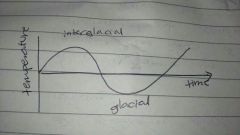
Interglacial warm and glacial cold periods
|
|
|
|
Biomes distribution
|
-as you might r further from the equator it gets colder
-the higher the altitude the colder it gets -when nearer to the sea it rains more due to wind over sea picks up moisture -ocean regulates the temperature -rainforest near the equator because hot and humid, the wind blowing east over ocean |
Equator ect
|
|
|
What does the biosphere provide
|
Goods - water, food, meat, fruit, crops
Services - nutrients cycle, biodiversity, climate regulation |
Goods and services
|
|
|
Threats to the biosphere
|
-deforestation
-mining of fossil fuels -quarrying -farming -overfishing |
|
|
|
CASE STUDY - borneo rainforest
|
By 2/3 of the forest has been logged over the past 40 years
-indigenous people, they are very sustainable as they move (nomadic) they use few goods but use all of the material with no waste |
|
|
|
CASE STUDY- great American oil spill
|
-gulf of Mexico in 2010
-oil rig was called deep water horizon -4.9 million barrels of oil spilled -explosion on the oil rig -BP oil -corexit was a toxic chemical used to disperse the oil particles, now though all it did was disperse through the whole ocean and not just the surface |
|
|
|
CASE STUDY - Brazil rainforest
|
-the Amazon rainforest is under threat from deforestation
-100000 Square kilometres destroyed every year -the population growth of Brazil is 1.5% per annum -during 2003 the rate of deforestation was 40% |
|
|
|
Sustainable management
|
Selective logging
Afforestation - planting trees Ecotourism brings money to the area Reserve for the wildlife |
|
|
|
Use of biosphere
|
It is a life support system. It provides us with goods (resources) and services. But there is an issue of sustainability of goods
|
|
|
|
Prevent flooding - soft engineering
|
Plants
Flood plains Dredging the rivers Making meanders in the rivers |
|
|
|
Prevent flooding - hard engineering
|
Dam restricting the amount of water
Embankment maximises river capacity Flood wall protects a city Channalisation expand the rivers Increase drain size Maintenance budget increase Divert Rivera from the towns |
|
|
|
CASE STUDY - Sheffield floods
|
13000 people witbout power
2 people died Evacuation Sewage entered water system causing disease Homes flooded Jobs and businesses suspended Housing market effeted Lost possession Sewage water in rivers Fallen trees |
|
|
|
Soil creep
|
Slow movement of mass movement of soil causing telegraph poles and walls to tilt
|
|
|
|
Helical flow
|
Water flows in corkscrew movement forming meanders
|
|
|
|
Water transportation
|
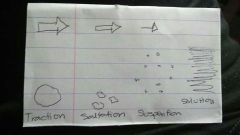
The way the water moves
|
|
|
|
Waterfalls formation
|

The water erodes the soft rock forming a plunge pool, the hard rock forms a ledge when there is an undercut, when this breaks off it causes the waterfall to retreat.
|
|
|
|
Solution - erosion
|
Alkaline rocks such as limestone are dissolved by acidic rain water
|
|
|
|
Hydraulic action - erosion
|
Fast flowing water is forced into cracks, breaking the river bank over time
|
|
|
|
Attrition - erosion
|
Rocks and stones wear each other away as they knock together
|
|
|
|
Abrasion - erosion
|
Where sand and pebbles are dragged along the river bed eroding it
|
|
|
|
CASE STUDY - sakurajima Japan
|
Pacific and eurasion plates
Volcano erupts 200 times a year People live there for the fertile land 7000 people live at the Base of the volcano There are shelters and alarms for the people living there |
|
|
|
CASE STUDY - hati earthquake
|
Magnitude 7.0
Happened in 2010 200000 people died North American and carried the tonic plates |
|
|
|
How can hazards (at plate boundaries) effect us? Long and short term
|
Short term - death, water mains breaks, destruction of buildings
Long term - financial issues, rebuilding schools and hospitals, job loses, homelessness |
|
|
|
Plate boundaries
|
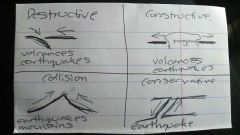
The four types of plate boundaries
|
|
|
|
Difference between oceanic and continental crust
|
Continental crust is thicker but less dense than oceanic crust
|
|
|
|
CASE STUDY - Japanese earthquake
|
15870 dead
The earth moved 10 inches Cost Japan $235 billion $1 billion donatins Tsunami caused 6.4 on the richter scake Nuclear power plant damaged causing radiation leak |
|
|
|
Two main types of volcanos
|
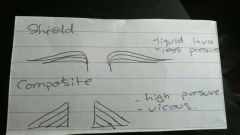
Shield and composite volcanoes
|
|
|
|
Earthquake
|
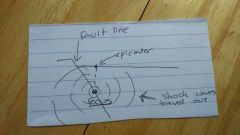
Diagram of earthquake
|
|
|
|
Volcano, things that happen
|
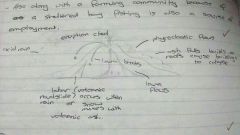
Lava flows
Lava bombs Pyroclastic flows Ash Mudslides Eruption clouds causes acid rain |
|
|
|
Small scale water solutions
|
Rope pump-
Two people to build it (uneducated) Cheap Low maintenance Rainwater harvesting- Three days to build Easy maintenance |
|
|
|
CASE STUDY - three gorges dam
|
GOOD-
Steady supply of water to the north Less flash flooding Employment More people can live there as there are less floods South gains money Tourism for the dam More industry =jobs BAD- Redirecting water Havant destroyed for the dam Polliton Loss of ancient site = loss of tourism Lost land Homelessness More industry |
|
|
|
CASE STUDY - Katse dam
|
GOOD -
Steady supply of water for farming Employment with opening industries 7000 people employed Tourism increased BAD - More farmland = pollution to the water (eutrophication) Habbits destroyed Homes flooded for space for dam Homelessness Less water for villages when it is redircted Not sustainable |
|
|
|
CASE STUDY - ganges river
|
India polluted right er
Eutrophication Disease causing death as it is drinking water Sewage and drinking source |
|
|
|
Eutrophication
|
Fertilisers are absorbed into ground water. Washed into rivers. Encourages algea to grow blocking sunlight to plants and with lack of oxygen fish die
|
|
|
|
Consequences of pollution to water
|
-chemical pollution
Toxic for bloodstream Death -radioactive waste Cancer Death -Sewage waste Disease/death -heat pollution Bacteria Kills fish |
|
|
|
CASE STUDY - australia droughts
|
EFFETE OF DROUGHT
Bush fires Dust storms Increased pressure to farmers Crown failures Economic decline Increased suicide rates Water restrictions Recycling water Trapping water |
|
|
|
CASE STUDY - the sonoran desert MEDC
|
Arizona in USA
Desert 120000 square miles EFFECTS crop failures Dust vowls Water shortages Wildfires Austin migration SOLUTIONS reduce water watse Redirect Colorado river |
|
|
|
CASE STUDY - drought in some LEDC
|
Is a belt of land which runs through Africa. North of the equator
Rainfalls only 1-2 months in a year Rainfall per annum is 250-450 mm Desert like land EFFECTS causes crop failures Soil erosion Animals forced to overgraze Death SOLUTIONS build walls to trap water Import water? |
|
|
|
Percolation
|
Movement of water in underlying rocks
|
Movement of water....
|
|
|
What is a water war
|
Conflicts between countries over water. Countries along a river can be blocked up river, downstream countries then fight over water. Global warming and population increase can increase the chance of it, also in Africa due to hot climate.
|
|
|
|
Human activity affecting water cycle
|
CO2 emissions increases in evaporation
Non-permable surfaces Storing water in pools ect Deforestation Less interception from leaves Run off causes flooding Nutrients lost in soil No plants |
|
|
|
Infiltration
|
Movement of the water into the soil from the surface
|
|
|
|
Saturation
|
When the soil s full of water
|
|

